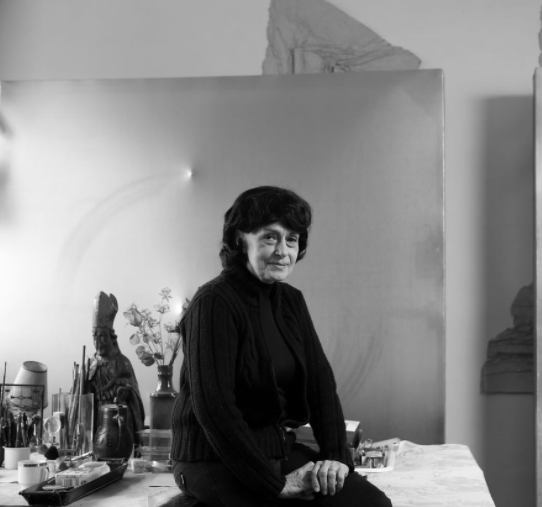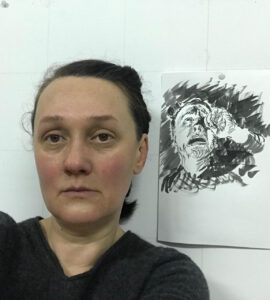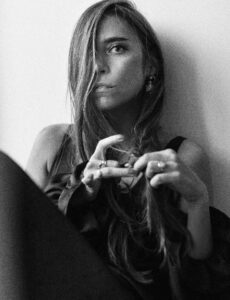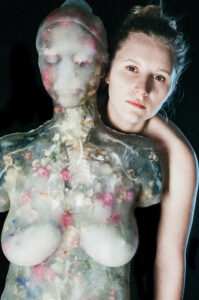Adéla Matasová

– born in 1940 in Prague, Czechoslovakia, a sculptor and graphic artist. At the end of the seventies, together with Jaroslava Severová, initiated regular meetings of artists, which resulted in two unique group exhibitions of artists from the “unofficial” scene (9 [1981], 15 [1982]). In 1990 she became the first professor of free art in what was then Czechoslovakia (between 1990 and 2003 she ran the Studio of Conceptual and Intermedia Creation at the Academy of Arts, Architecture and Design in Prague, from 2005 to 2012 she worked at the University of West Bohemia in Pilsen). Initially she worked with resin and papier mache, later she began to focus on intermedia overlaps connected with sound and the new media.
We do not choose the time in which we are born
My artistic inclinations have accompanied me since childhood, whether it was singing, recitation, dancing or painting, these interests always outweighed that which was imposed, what I had to do. The pleasant euphoric feelings of these activities were also a cure for my childhood hypersensitivity and puberty xxx. Even in 1990, when I started teaching at the Academy of Arts, Architecture and Design in Prague, I could not separate my creative work from teaching. My curiosity has become part of our common journey of discovery with my students.
Each phase of my artistic activity follows in a specific way, expression, material used and form of processing the previous phase. If anything drove me forward, it was the ability to discover questions, inexplicable for me at that time: how far can my mind reach and transcend the boundary of the real and reveal somewhat the secret stored in my unconscious with the help of a focused mind. Recently, the topic of the existence of being, following the consciousness of man in connection with the cosmos, has become my focus. An example is one of my recent exhibitions Infinite Convergence and the subtitle of the works We Ever Swear1 or EveryoneSometimes Wanted to Touch Being2.
A burning topic, even with regard to my life experience, is the question of equality between men and women, which I perceive as a cultural achievement of an advanced society with an emphasis on dignity in action, equal pay at work, equal opportunities and ethnicity. But I must admit that our society has not yet reached this level, so the field is still open to dissatisfaction. In the field of equality, there are certain given facts: a woman gives birth to a child and a woman’s skeleton is more fragile than man’s. The consequences that follow from this always create a contradictory situation in which a woman is not much regarded.
When I studied at the Academy of Fine Arts in Prague (1958–1964), we had two women and about ten men in the studio. After two years of preparation, I went to a special course of Vladimír Sychra’s Studio, where it was more gender-balanced. I can’t say that there was any discrimination against female students, rather there was a kind of grade hierarchy. Senior students simply wouldn’t talk to us. Vladimir Sychra was an intellectual, he had his natural dignity and his dealings with us were impersonal.
My generation was a generation of solitaires. As soon as we left school, all possibilities were closed to us for political reasons. In 1965 my daughter was born, my husband was serving in the army, two years later my father died and my mother fell ill. I worked on my things at night. The brief time of freedom around 1968 was artistically too short for me. I still managed to go on a UNESCO scholarship to Paris, from which I had to return earlier due to the student riots in May, and when I arrived in Prague, Soviet tanks were standing on Wenceslas Square. Nevertheless, I completed several of my own exhibitions until 19713. But that was the end of free art for me for many years. The only option left was to “work for the drawer” as it was said at the time.
I tried to make a living somehow for the next few years. I worked on architectural realizations and also restored a lot. At work, my colleagues and I helped each other, everyone had a problem making a living at the time. After 1971, existing investors in the field of architecture and other fields were replaced by more politically savvy ones. Work-in-progress has been suspended for a long time or even canceled, which happened to me too. I inadvertently got into debt and it took me long to repay it. In those turbulent times, I mostly met with Jaroslava Severová and other classmates from the Academy of Fine Arts, but those meetings were sporadic. The men, on the other hand, went to a pub for a beer regularly and sometimes took their partners. But it was mainly men’s company. They knew about each other’s whereabouts far more than we did, but mainly informed each other about what was happening among artists, about job opportunities, about cellar studio exhibitions and about music and other underground events – see the Jazz Section, which later published interesting miscellanies that took the long way round to get to us.
Time passed, the political situation became more and more difficult, so it occurred to me and Jaroslava to organize similar meetings of women as well. We invited basic circle of acquaintances and they invited their friends, so our society grew. We met in the Makarska wine bar in a closed room called the Vagon. I remember the first contribution was the story by Věra Janoušková about the Polish artist Alina Szapoczniková, who came to the Academy of Arts, Architecture and Design in Prague straight from the concentration camp after the war and became their classmate. Later, after 1968, they all visited her in Paris, where Alina emigrated with her husband, a talented designer. Alina was a great inspiration to Eva Kmentová. I was also very interested in her work and destiny and all the stories around her, especially her bravery. The other conversations immediately went underway. The writer Alexandra Berková came several times, with whom I met again working at the Literary Academy in 2005. Otherwise, we shared our worries, we talked about our work with an interest in other professions, because there were also architects and glassmakers and, of course, about the political situation. And we also laughed a lot4.
In the Wagon, we pulled out suspicious wires, thinking we were being tapped. It was more of a joke, because, as we found out, it was a wire radio, such a unified socialist good mood tuner, a rarity of its kind today. We did not create any conscious feminist program. For the time being it sufficed to us that we got together as women, that we had something to look forward to, and that it was all fun and it pulled us together. God knows what and how it would have developed over time. The first joint program was our two exhibitions. In 1981 at the Mělník Tower, a year later at Dobříš. Květa Křížová took over the curation and made a selection of artists, which was not an enviable situation at all. Our company was open to anyone who wanted to come, of course friends of friends, female and male, but the choice for the exhibitions was necessary. The opening at Dobříš took place without any harm. There was always a danger that someone would come and close the exhibition on spot. A lot of people gathered. But the men who came to the opening, mostly the artists’ husbands, looked as if ashamed of their wives. I don’t know exactly how to describe it, but it seemed to be beneath their dignity that their wives became entangled in such a situation. We were also reproached (although the then selection of artists are still resounding names today) that we put together an exhibition of such diverse fields as designers, glassmakers, sculptors, graphic artists or painters, which is united only by the fact that they all are women. It would not be such a problem today. The art society was quite selected at the time. Of course, we read Simone de Beauvoir, but each of us rather privately – it was instructive, but not yet feasible.
But what was our reality then? In 1991, I traveled with my family to America for a longer period of time, where I met a young New Yorker who asked me about the Czech situation and the feminist organization of women in the fight for equality. After almost thirty years of living behind the Iron Curtain, in complete isolation from the Western world, her questions seemed a little superfluous, even funny. While women in our country worked to exhaustion, demagogically worshiped by socialist propaganda, women in the West built their position in the free world of economically developed countries. We lived a completely different social and political experience. For the time being, we were just beginning to understand that we were finally living in a free world, and it was necessary to deal with this new situation honorably. I certainly did not have a satisfactory explanation for the young student in this regard. It often happened to me when I spoke to a foreigner in America that they could not understand our political and social history at the time and even thought it was a kind of personal excuse.
At the end of the 1980’s, the situation began to relax and I was given the opportunity to exhibit at the Basel Biennial. The organizer was the Art Center, then the only organization with international contacts. I was working with linen papier mache at the time. This unusual material was my own discovery, and I was able to create larger installations with it. Working with paper was then an international trend in art, especially in Western Europe.5 As my work was a success, another offer followed from the International Art Exhibition in Chicago. Of course, I could not go to America, but my father-in-law, a world-renowned occupational therapist, had successful students who emigrated abroad. They sent me an invitation stating that they would pay for everything and vouch for me, so I was allowed to go to the West. It was a shock to me. Yayoi Kusama exhibited with me at the show, whom I admired very much. I could meet her and see her work live. After the exhibition, I lent my objects to the Baruch Gallery in Chicago for a year.
At the beginning of 1990, I started teaching at the Academy of Arts, Architecture and Design in Prague, where I ran the Studio of Conceptual and Intermedia Creation until 200367. As far as women’s emancipation is concerned, the situation at school seemed far more balanced to me than in the past. This was mainly reflected in the respect and seriousness with which the work and personalities of the students were approached. But I am under no illusions that much has changed in this regard in my professional life. Even because of globalization, which is constantly creating new political-socio-cultural conditions, the path to gender equality is becoming increasingly difficult89101112.
The text was created in collaboration with Marianna Placáková (2021).
1Image: Adéla Matasová, We've all sworn sometime, video art, 2019. Courtesy of the artist.2Adéla Matasová, Infinite convergence, Ústí n. L.: House of Art 2019.
3Image: Adéla Matasová, Lips, synthetic resin, 118 x 95 cm, 1970. Courtesy of the artist.
4Adéla Matasová, Female Encounters, in: Terezie Petišková (ed.), Grey Gold. Czech and Slovak Female Artists over 65, Brno: House of Art 2014, s. 76–78.
5Image: Adéla Matasová, Situation I., installation, linen, wood, 1989. Courtesy of the artist.
6Image: Adéla Matasová, Fictitious Projects, Václav Špála Gallery, Prague, 2001. Courtesy of the artist.
7Image: Adéla Matasová, Hidden Images, view to installation, Museum of Contemporary Art, Denver, 2004. Courtesy of the artist.
8Adéla Matasová. Stopping in the time 1967–1997, Prague: National Gallery 1997.
9Martina Pachmanová, Charlotta Kotík, Adéla Matasová. Fictive project, Prague: Gallery of Václav Špál 2001.
10Jiří Machalický, Adéla Matasová. Interspaces, Praha: Gallery Montanelli 2005.
11Jiří Fiala, Jiří Machalický, Charlotta Kotík, Adéla Matasová, Prague: Gallery 2008.
12Jen Kratochvíl (ed.), Adéla Matasová. Interface, Prague: VŠUP 2019.
– narozena 1940 v Praze v Československu, sochařka a grafička, na konci sedmdesátých let iniciovala společně s Jaroslavou Severovou pravidelná setkání umělkyň, z nichž vznikly dvě ojedinělé skupinové výstavy umělkyň z „neoficiální“ scény (9 [1981], 15 [1982]), v roce 1990 se stala první profesorkou volného umění v tehdejším Československu (mezi lety 1990 až 2003 vedla Ateliér konceptuální a intermediální tvorby na Vysoké škole uměleckoprůmyslové v Praze, v letech 2005 až 2012 působila na Západočeské univerzitě v Plzni), v tvorbě objektů a prostorových instalací ze začátku pracovala s pryskyřicí a papírovou hmotou, později se začala věnovat intermediálním přesahům, spojených se zvukem a novými médii.
Nevybíráme si dobu, ve které se narodíme
Umělecké sklony mě provází už od dětství, ať to byl zpěv, recitace, tanec nebo malování, vždy tyto mé zájmy převyšovalo to, co bylo vynucené, co jsem musela. Příjemné euforické pocity při této činnosti byly také jakýmsi lékem na mou dětskou přecitlivělost a pubertální křivdy. Ani v roce 1990, kdy jsem začínala učit na Vysoké škole uměleckoprůmyslové v Praze, jsem nedokázala svou tvůrčí práci oddělovat od té pedagogické. Moje zvídavost se stala i pro studenty součástí naší společné cesty za poznáním.
Každá fáze mé výtvarné činnosti navazuje specifickým způsobem, výrazem, použitým materiálem a formou zpracování na fázi práce předcházející. Jestli mě ale něco hnalo dopředu, byla to schopnost objevovat pro sebe zatím nevysvětlitelné otázky: kam až může moje mysl dosáhnout a překročit hranici reálného a poodhalit tajemství uložené v mém nevědomí prostřednictvím soustředěné mysli. V poslední době se stalo mým středobodem téma jsoucnosti bytí, navazující na vědomí člověka v souvislosti s kosmem. Příkladem může být jedna z mých posledních výstav Nekonečná konvergence a podnázvy děl Každý jsme někdy přísahali,1 nebo Každý jsme se někdy chtěli dotknout jsoucnosti2.
Palčivé téma i s ohledem na mé životní zkušenosti je otázka rovnoprávnosti mezi mužem a ženou, kterou vnímám jako kulturní výdobytek vyspělé společnosti s důrazem na důstojnost v jednání, rovné odměny v práci, stejné možnosti uplatnění a etnické sounáležitosti. Musím ale přiznat, že naše společnost k této úrovni stále ještě nedospěla, takže pole je stále otevřené pro nespokojenost. V oblasti rovnoprávnosti existují určité danosti: žena rodí děti a ženská kostra je křehčí než mužská. Důsledky, které z toho plynou, nastolují vždy rozporuplnou situaci, v níž nejsou brány na ženu přílišné ohledy.
Když jsem studovala na AVU v Praze (1958–1964), byly jsme v ateliéru dvě ženy a přibližně deset mužů. Po dvouleté přípravce jsem odešla do speciálky ateliéru Vladimíra Sychry, kde už to bylo genderově vyrovnanější. Nemohu říct, že by zde existovala nějaká diskriminace studentek, spíše zde byla jakási ročníková hierarchie. Studenti z vyšších ročníků se s námi prostě nebavili. Vladimír Sychra byl intelektuál, měl svou přirozenou důstojnost a jeho jednání s námi bylo neosobní.
Moje generace byla generací solitérů. Sotva jsme vyšli ze školy, už se pro nás z politických důvodů všechny možnosti uzavřely. V roce 1965 se mi narodila dcera, manžel byl na vojně, o dva roky později zemřel můj otec a maminka onemocněla. Pracovala jsem na svých věcech po nocích. Krátký čas svobody okolo roku 1968 tak byl pro mě po umělecké stránce příliš krátký. Ještě jsem stačila odjet na UNESCO stipendium do Paříže, z něhož jsem se musela vrátit dříve kvůli studentským květnovým nepokojím, a když jsem přijela do Prahy, stály na Václaváku sovětské tanky. Přesto jsem do roku 1971 absolvovala několik vlastních výstav3. Tím to ale s volným uměním pro mě na mnoho let skončilo. Jediná možnost zůstala dělat do šuplete, jak se tenkrát říkalo.
Další roky jsem se snažila nějak uživit. Pracovala jsem na architektonických realizacích a také hodně restaurovala. Pracovně jsme si hlavně s kolegyněmi vzájemně pomáhaly, každý měl v té době problém uživit se. Po roce 1971 byly stávající investoři v oblasti architektury i v jiných oborech vyměněni za politicky zdatnější. Rozpracované zakázky se na dlouhou dobu pozastavily, nebo dokonce zrušily, což se stalo i mně. Nechtěně jsem se zadlužila a své dluhy dlouho splácela.
V těchto pohnutých časech jsem se nejvíce stýkala s Jaroslavou Severovou a dalšími spolužačkami z AVU, ale byla to setkání sporadická. Muži oproti nám chodili pravidelně do hospody na pivo a někdy přibrali i své partnerky. Byla to ale především pánská společnost. Měli jeden o druhém daleko větší povědomí než my, ale hlavně se vzájemně informovali o dění mezi umělci, o možnostech práce, o sklepních ateliérových výstavách a o hudebních i jiných akcích undergroundu – viz Jazzová sekce, jež později vydávala zajímavé sborníky, které se k nám dostávaly k zapůjčení velkou oklikou.
Čas plynul, politická situace byla čím dál tíživější, a tak nás s Jaroslavou napadlo zorganizovat také taková setkání žen. Vyzvaly jsme základní okruh známých a ti pozvali své přátele, a tak se naše společnost rozrůstala. Scházely jsme se v Makarské vinárně v uzavřené místnosti, které se říkalo Vagon. Vzpomínám si, že takovým prvním příspěvkem bylo vyprávění Věry Janouškové o polské umělkyni Alině Szapocznikové, která po válce přicestovala na VŠUP v Praze rovnou z koncentráku a stala se jejich spolužačkou. Později po roce 1968 ji všichni navštívili v Paříži, kam Alina se svým mužem, nadaným designérem, emigrovala. Alina byla velkou inspirací pro Evu Kmentovou. Mě její práce a osud a všechny příběhy kolem ní také velmi zajímaly, hlavně její statečnost. Ostatní rozhovory se bezprostředně rozproudily. Několikrát přišla spisovatelka Alexandra Berková, se kterou jsem se pracovně znovu setkala až v roce 2005 na Literární akademii. Jinak jsme se podílely o své starosti, hovořily jsme o své práci se zájmem o jiné profese, protože mezi nás chodily i architektky a sklářky a samozřejmě o politické situaci. A také jsme se hodně nasmály.4
Ve Vagonu jsme vytrhávaly podezřelé dráty v domnění, že nás odposlouchávají. Byla to spíš legrace, protože, jak jsme zjistily, to byl rozhlas po drátě, takový jednotný socialistický budič dobré nálady, dnes svého druhu rarita. Nevytvářely jsme nějaký uvědomělý feministický program. Zatím nám stačilo, že jsme se jako ženy daly dohromady, že máme něco, na co se můžeme těšit a že to všechny baví a stmeluje. Bůh ví, co a jak by se bylo časem z toho vyvinulo. Prvním společným programem byly naše dvě výstavy. V roce 1981 v Mělnické věži, o rok později v Dobříši.56 Květa Křížová se ujala kurátorství a udělala výběr umělkyň, což nebyla vůbec záviděníhodná situace. Naše společnost byla totiž otevřená pro každého, kdo chtěl přijít, samozřejmě kamarádky kamarádek, přátelé přátel, ale výběr k výstavám byl nutný. Vernisáž v Dobříši proběhla bez pohromy. Vždy totiž hrozilo nebezpečí, že někdo přijde a výstavu zavře. Sešlo se hodně lidí. Muži, kteří přišli na zahájení, většinou manželé výtvarnic, se ale jako by za své ženy styděli. Nevím přesně, jak to popsat, ale jako by bylo pod jejich úroveň, že se jejich ženy zamotaly do takové situace. Také nám bylo vyčteno (i když výběr výtvarnic jsou ještě dnes stále zvučná jména), že koncipujeme výstavu tak rozmanitých oborů jako jsou designérky, sklářky, sochařky, grafičky anebo malířky, které spojuje jen to, že jsou ženy. Dnes už by to takový problém nebyl. Výtvarná společnost byla tenkrát dost selektovaná. Simone de Beauvoir jsme samozřejmě četly, ale spíše každá soukromě – bylo to poučné, ale zatím nerealizovatelné.
Ale jaká byla tedy ta naše tehdejší skutečnost? V roce 1991 jsem se svojí rodinou vycestovala na delší čas do Ameriky, kde jsem se setkala s mladou Newyorčankou, která se mě vyptávala na českou situaci a na feministickou organizovanost žen v boji za rovnoprávnost. Po téměř třicetiletém životě za železnou oponou, v naprosté izolaci od západního světa, mně přišly její otázky tak trochu nadbytečné, až úsměvné. Zatímco u nás ženy pracovaly do úmoru, demagogicky na oko uctívané socialistickou propagandou, tak ženy na Západě budovaly své postavení ve svobodném světě hospodářsky vyspělých zemí. My jsme žily s naprosto jinou sociální a politickou zkušeností. Zatím jsme teprve začínaly chápat, že konečně žijeme ve svobodném světě a bylo nutné se s touto novou situací se ctí vypořádat. V tomto ohledu jsem pro mladou studentku rozhodně neměla uspokojivé vysvětlení. Často se mi stávalo, když jsem mluvila s nějakým cizincem v Americe, že vůbec nemohl pochopit naši politickou a sociální anamnézu tehdejší doby a dokonce si myslel, že je to nějaká osobní výmluva.
Koncem 80. let se situace začala uvolňovat a já dostala možnost vystavovat na Bienále v Baselu. Organizátorem bylo Art centrum, tehdy jediná organizace s mezinárodními kontakty. Pracovala jsem tehdy s lněnou papírovou hmotou. Tento neobvyklý materiál byl mým vlastním objevem a mohla jsem s ním vytvářet instalace větších rozměrů. Práce s papírem byla tehdy mezinárodním trendem v umění, hlavně v západní Evropě7. Jelikož měly mé práce úspěch, následovala další nabídka na International Art Exposition v Chicagu. Samozřejmě bych do Ameriky nemohla jet, ale můj tchán, světově uznávaný lékař v oboru pracovního lékařství, měl všude v zahraničí úspěšné žáky, kteří emigrovali. Ti mi poslali pozvání s tím, že vše hradí a že se za mě zaručí, a tak mi bylo umožněno vyjet na Západ. Byl to pro mě šok. Na výstavě se mnou vystavovala Yayoi Kusama, kterou jsem velmi obdivovala. Mohla jsem se s ní potkávat a vidět naživo její dílo. Po skončení výstavy si pak mé objekty zapůjčila na rok Baruch Gallery v Chicagu.
Začátkem roku 1990 jsem začala učit na VŠUP v Praze, kde jsem vedla do roku 2003 ateliér konceptuální a intermediální tvorby89. Co se týče emancipace žen, jevila se mi situace na škole daleko vyváženější než v minulosti. Hlavně se to projevovalo v respektu a vážnosti, s jakou se přistupovalo k tvorbě a osobnostem studentek. Nedělám si ale velké iluze, že se toho v tomto ohledu v profesním životě příliš změnilo. I kvůli globalizaci, kvůli níž vznikají stále nové politicky-sociálně-kulturní podmínky, je cesta ke genderové rovnosti stále složitější.1011121314
Text vznikl ve spolupráci s Mariannou Placákovou.
1Obrázek: Adéla Matasová, Každý jsme někdy přísahali, videoart, 2019. S laskavým svolením umělkyně.2Adéla Matasová. Nekonečná konvergence, Ústí n. L.: Dům umění 2019.
3Obrázek: Adéla Matasová, Rty, syntetická pryskyřice, 118 x 95 cm, 1970. S laskavým svolením umělkyně.
4Adéla Matasová, Female Encounters, in: Terezie Petišková (ed.), Grey Gold. Czech and Slovak Female Artists over 65, Brno: Dům umění 2014, s. 76–78.
5Květa Křížová, 9, Mělník: Galerie ve věži 1981.
6Květa Křížová, 15, Dobříš: Městské kulturní středisko 1982.
7Obrázek: Adéla Matasová, Situace I, instalace, lněná hmota, dřevo, 1989. S laskavým svolením umělkyně.
8Obrázek: Adéla Matasová, Fictitious Projects, Galerie Václava Špály, Praha, 2001. S laskavým svolením umělkyně.
9Obrázek: Adéla Matasová, Hidden Images, view to installation, Museum of Contemporary Art, Denver, 2004. S laskavým svolením umělkyně.
10Adéla Matasová. Zastavení v čase 1967–1997, Praha: Národní galerie 1997.
11Martina Pachmanová, Charlotta Kotík, Adéla Matasová. Fiktivní projekty, Praha: Galerie Václava Špály 2001.
12Jiří Machalický, Adéla Matasová. Meziprostory, Praha: Galerie Montanelli 2005.
13Jiří Fiala, Jiří Machalický, Charlotta Kotík, Adéla Matasová, Praha: Gallery 2008.
14Jen Kratochvíl (ed.), Adéla Matasová. Interface, Praha: VŠUP 2019.
![]()


